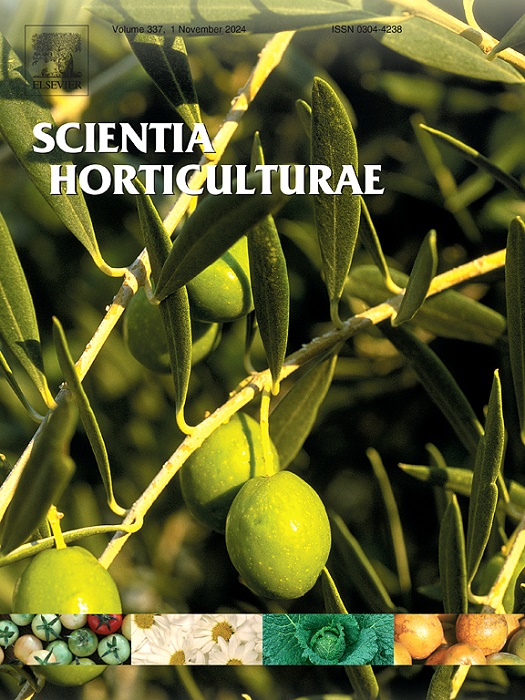The resistance of litchi fruit to Peronophythora litchii is associated with lignin biosynthesis and reactive oxygen species metabolism
IF 3.9
2区 农林科学
Q1 HORTICULTURE
引用次数: 0
Abstract
Litchi downy blight is a destructive disease that severely reduces yield and causes postharvest losses in litchi fruit. The varieties ‘Heiye’ (HY) and ‘Guiwei’ (GW) were identified as highly resistant and susceptible to Peronophythora litchii infection, respectively. We further investigated the differences between resistant and susceptible varieties through transcriptomic and biochemical analyses to uncover the mechanisms underlying postharvest resistance to litchi downy blight in litchi fruit. RNA-seq analysis of postharvest litchi fruit infected with P. litchii revealed that differentially expressed genes between HY and GW were primarily associated with phenylpropanoid biosynthesis and reactive oxygen species (ROS)-related pathways. The analysis of key metabolites in phenylpropanoid biosynthesis showed a significant difference in lignin content between the two varieties. Fifteen upregulated genes (C4H-1, COMT-1, CAD-6, and POD-7) were identified by RNA-seq and qRT-PCR. These genes correspond to highly active enzymes of C4H, CAD and POD involved in lignin biosynthesis, which were detected in P. litchii-inoculated HY fruit compared to GW. These factors contributed to the higher lignin content in HY fruit. Additionally, the ROS scavenging ability of HY pericarp was superior to that of GW, as evidenced by reduced ROS and malondialdehyde (MDA) levels, increased activities of superoxide dismutase (SOD) and catalase (CAT), and increased expression of two SOD genes and two CAT genes following P. litchii infection. These findings suggest that lignin biosynthesis and ROS metabolism play crucial roles in maintaining litchi fruit resistance to P. litchii, providing valuable insights for breeding and developing resistant varieties.
荔枝果实对荔枝疫霉的抗性与木质素的生物合成和活性氧代谢有关
荔枝霜枯病是一种严重影响荔枝果实产量和采后损失的破坏性病害。鉴定品种“黑叶”(HY)和“贵味”(GW)分别为荔枝疫霉高抗和敏感品种。我们通过转录组学和生化分析进一步研究了抗性和敏感品种之间的差异,以揭示荔枝果实采后抗霜枯病的机制。对侵染荔枝荔枝果实的RNA-seq分析表明,HY和GW之间的差异表达基因主要与苯丙素生物合成和活性氧(ROS)相关途径有关。苯丙素生物合成关键代谢产物分析表明,两个品种间木质素含量差异显著。通过RNA-seq和qRT-PCR鉴定出15个上调基因(C4H-1、COMT-1、CAD-6和POD-7)。这些基因与参与木质素生物合成的C4H、CAD和POD高活性酶相对应,与GW相比,在HY荔枝接种的果实中检测到这些基因。这些因素是青果木质素含量较高的主要原因。此外,HY果皮清除ROS的能力优于GW,表现为感染后ROS和丙二醛(MDA)水平降低,超氧化物歧化酶(SOD)和过氧化氢酶(CAT)活性升高,SOD和CAT两个基因表达增加。研究结果表明,木质素的生物合成和活性氧代谢在荔枝果实抗荔枝病的维持中起着重要作用,为荔枝品种的选育提供了有价值的见解。
本文章由计算机程序翻译,如有差异,请以英文原文为准。
求助全文
约1分钟内获得全文
求助全文
来源期刊

Scientia Horticulturae
农林科学-园艺
CiteScore
8.60
自引率
4.70%
发文量
796
审稿时长
47 days
期刊介绍:
Scientia Horticulturae is an international journal publishing research related to horticultural crops. Articles in the journal deal with open or protected production of vegetables, fruits, edible fungi and ornamentals under temperate, subtropical and tropical conditions. Papers in related areas (biochemistry, micropropagation, soil science, plant breeding, plant physiology, phytopathology, etc.) are considered, if they contain information of direct significance to horticulture. Papers on the technical aspects of horticulture (engineering, crop processing, storage, transport etc.) are accepted for publication only if they relate directly to the living product. In the case of plantation crops, those yielding a product that may be used fresh (e.g. tropical vegetables, citrus, bananas, and other fruits) will be considered, while those papers describing the processing of the product (e.g. rubber, tobacco, and quinine) will not. The scope of the journal includes all horticultural crops but does not include speciality crops such as, medicinal crops or forestry crops, such as bamboo. Basic molecular studies without any direct application in horticulture will not be considered for this journal.
 求助内容:
求助内容: 应助结果提醒方式:
应助结果提醒方式:


